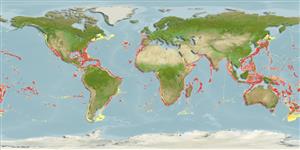Common names from other countries
分类 / Names
俗名 | 同种异名 | Catalog of Fishes(属, 种) | ITIS | CoL | WoRMS | Cloffa
Teleostei >
Scombriformes (Mackerels) >
Gempylidae (Snake mackerels)
Etymology: Lepidocybium: Greek, lepis = scale + Greek, kybion, -ou = tunna (Ref. 45335).
Environment: milieu / climate zone / depth range / distribution range
生态学
海洋 底中水层性; 海洋洄游的 (Ref. 51243); 深度上下限 200 - 1100 m (Ref. 44037). 深水域; 50°N - 56°S, 180°W - 180°E (Ref. 6181)
Tropical and temperate seas of the World, but probably not occurring in the northern Indian Ocean. Northwest Atlantic: Canada (Ref. 5951). Eastern Atlantic: known from 13°N off Guinea to Lobutu, Angola (Ref. 10816).
熱帶與世界的溫帶海洋, 但是可能不出現在印度洋北部。 東大西洋: 已知來自 13 ° N 幾內亞外海到 Lobutu ,安哥拉了。 (參考文獻 10816)
大小 / 重量 / 年龄
Maturity: Lm ? range ? - ? cm
Max length : 200 cm SL 雄鱼/尚未辨别雌雄; (Ref. 6181); common length : 150 cm SL 雄鱼/尚未辨别雌雄; (Ref. 6181); 最大体重: 45.0 kg (Ref. 3403)
背棘 (总数) : 8 - 9; 背的软条 (总数) : 16 - 18; 臀棘: 1 - 2; 臀鳍软条: 12 - 14; 脊椎骨: 31. Body almost uniformly dark brown, becoming almost black with age. Pelvic fins well developed, with I spine and 5 soft rays (Ref. 9784). Prominent lateral keel on caudal peduncle, flanked by smaller accessory keels above and below (Ref. 26938).
身体几乎全黑褐色, 变成几乎黑色随着年龄。 腹鳍发展良好的, 与 I 棘与 5个软鳍条.(参考文献 9784) 突出的侧龙骨在尾梗上, 体侧有比较小的附属龙骨脊上面与下面.(参考文献 26938)
Occurs mainly over the continental slope, down to 200 m and more (Ref. 6181). Migrates upward at night (Ref. 6181). Feeds on squid, crustaceans and a wide variety of fishes (Ref. 6181). Flesh oily and may have purgative properties (Ref. 9784). Sometimes caught by tuna long-liners (Ref. 26938). Marketed frozen and as fish cakes in Japan (Ref. 9302).
主要生存在大陆斜坡上, 向下至 200 公尺与更多.(参考文献 6181) 向上回游在晚上。 (参考文献 6181) 吃乌贼,甲壳动物与各式各样的鱼。 (参考文献 6181) 肉多油的而且可能有泻剂的成份.(参考文献 9784) 有时被鲔鱼延绳钓捕获了。 (参考文献 26938) 在市场上冷冻销售了与如鱼肉炸饼在日本.(参考文献 9302)
Life cycle and mating behavior
Maturities | 繁殖 | Spawnings | Egg(s) | Fecundities | 仔鱼
熱帶與世界的溫帶海洋, 但是可能不出現在印度洋北部。 東大西洋: 已知來自 13 ° N 幾內亞外海到 Lobutu ,安哥拉了。 (參考文獻 10816)
Nakamura, I. and N.V. Parin, 1993. FAO Species Catalogue. Vol. 15. Snake mackerels and cutlassfishes of the world (families Gempylidae and Trichiuridae). An annotated and illustrated catalogue of the snake mackerels, snoeks, escolars, gemfishes, sackfishes, domine, oilfish, cutlassfishes,. scabbardfishes, hairtails, and frostfishes known to date. FAO Fish. Synop. 125(15):136 p. (Ref. 6181)
CITES (Ref. 128078)
Not Evaluated
人类利用
渔业: 低经济
工具
特别资料
下载 XML
网络资源
Estimates based on models
Preferred temperature (Ref.
115969): 7 - 14.4, mean 9.9 (based on 642 cells).
Phylogenetic diversity index (Ref.
82804): PD
50 = 1.0000 [Uniqueness, from 0.5 = low to 2.0 = high].
Bayesian length-weight: a=0.01175 (0.00597 - 0.02312), b=2.98 (2.79 - 3.17), in cm Total Length, based on LWR estimates for this species & (Sub)family-body (Ref.
93245).
营养阶层 (Ref.
69278): 4.3 ±0.67 se; based on food items.
回复力 (Ref.
120179): 低的, 最小族群倍增时间4.5 - 14 年 (Assuming tm=4-5).
Fishing Vulnerability (Ref.
59153): Very high vulnerability (90 of 100).
Climate Vulnerability (Ref.
125649): Moderate vulnerability (39 of 100).
